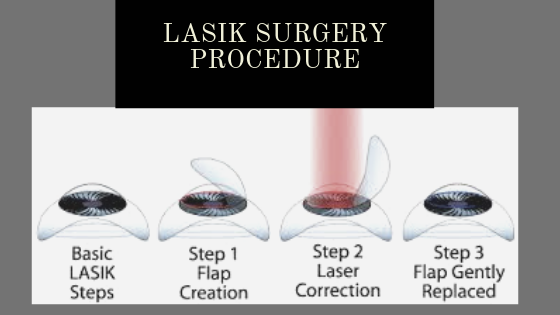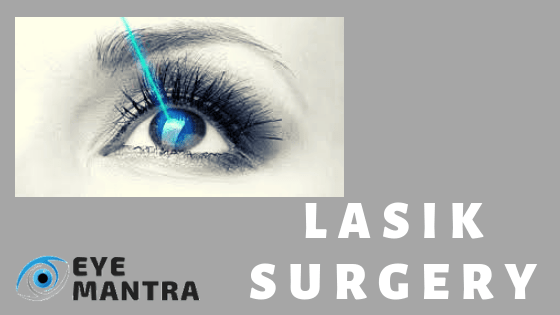Contents
What Is LASIK Surgery?
LASIK surgery is a common laser vision correction surgery. In most cases, LASIK can fully correct nearsightedness, farsightedness, and astigmatism, and reduce or eliminate the need for prescription glasses or contact lenses. It can also help in restoring the 6 by 6 vision.
LASIK (laser-assisted in situ keratomileuses) comes under a type of laser refractive surgery. It is one of the best-known surgery and most commonly performed surgery. A special type of cutting laser is used to precisely change the shape of your cornea — the dome-shaped transparent tissue at the front of your eye — to improve vision.
Need of LASIK Surgery
LASIK surgery helps in the correction of any of these vision problems:
- Nearsightedness (myopia):
When your eyeball is slightly longer than normal/when the cornea curves too sharply, this problem occurs. Due to which the light rays focus in front of the retina and results in blurred distant vision. You can see objects that are close clearly, but not those that are far away.
When you have a smaller than average eyeball or cornea that is too flat, the light gets focused behind the retina instead of right on it. This makes the near vision, and sometimes distant vision, blurry.
When the cornea curves/flattens unevenly, the result is astigmatism. Astigmatism results in a disruption in the focus of near and distant vision.
Types of LASIK Surgery
Wavefront Optimized LASIK
Wavefront Optimized LASIK procedure uses detailed measurements of the curvature of your cornea. This is done to preserve the natural aspheric shape of the front surface of the eye, thus reducing spherical deviation that may occur with the other types of laser refractive surgery.
Wavefront-Guided LASIK
Wavefront-Guided LASIK procedure uses the detailed measurements of how light waves travel through your eye to create a laser treatment that is completely personalized for your eye anatomy and your vision needs.
Topography-guided LASIK
CONTOUR Vision is a type of laser vision correction that uses some of today’s most advanced mapping technologies to create a personalized treatment for your eyes.
All-Laser LASIK
In this procedure, a femtosecond laser is used for creating the corneal flap. It eliminates the need for a bladed surgical instrument to touch the eye.
LASIK Surgery Procedure

The LASIK procedure involves two steps:
- The creation of the corneal flap by a precision flap making an instrument
- The reshaping of the cornea with an excimer laser.
The excimer laser is used for reshaping the cornea by removing tissue from its middle layer. The procedure generally takes ten minutes of operating room time, during which the laser is used for less than a minute on each eye. However, the actual duration of the procedure may vary according to the type and amount of correction needed.
The steps involved in the procedure are as follows:
- Before the procedure begins, eye drops are used for numbing your eyes.
- While you relax on the treatment bed, your eyelids will gently be held open and a precision flap-making instrument will be carefully positioned.
- You will be asked to focus on a special kind of fixation light. The surgeon will then activate a precision instrument electronically and seconds later he will be able to fold away a corneal flap, revealing the middle layer of the cornea.
- The cornea will be reshaped by an excimer laser.
More specifically to treat myopia (nearsightedness) the cornea is flattened for reducing the converging power of the eye. This will be achieved by removing more tissue from the centre of the cornea than around. To cure hyperopia (farsightedness) the central cornea is steepened for enhancing the converging power of the eye.
This is achieved by removing more tissue from the periphery than the centre. To deal with astigmatism, the cornea is made more spherical (uniformly curved). By changing the pattern of the beam, the tissue is removed in one direction more than the other. The corneal flap is then repositioned in its place. The natural forces hold the flap in place until surface healing is complete.
Cost of LASIK Surgery
LASIK cost varies from centre to centre from as low as five thousand rupees per eye to as high as over a lakh of rupees. Many laser centres are typically using older technology that is far cheaper due to minimal medical safety protocols and quality control. Some centers may charge you this much for very poorly maintained lasers, re-use disposables, and do not have the expertise to deal with complications. In a surgery where tests like HIV are not done for patients, it becomes extremely important to tread with caution when choosing a LASIK centre.
The standard rate of basic Lasik surgery in India is about 50,000 INR to 1 lakh. Basic Lasik treatment in India could cost up to 20,000 to 50,000 INR while the high-end hospitals that are providing premium services with bladeless Lasik treatment can charge up to a lakh or higher.
The Price of the surgery varies from person to person depending on the equipment used and many other factors involved.
Risks of LASIK Surgery
Risks of LASIK include:
Dry eyes
LASIK surgery can cause a temporary decrease in tear production. For the first 6 months or so after your surgery, your eyes may feel unusually dry as they are healing. Dry eyes can result in a reduction in the quality of your vision. Your eye doctor might recommend using eyedrops during this time. If you are experiencing severe dry eyes, you could opt for another procedure to get special plugs put in your tear ducts to prevent your tears from draining away from the surface of your eyes.
Glare, halos, and double vision
After surgery, you may have difficulty seeing at night. You might notice glare, halos around bright lights, or blurred vision. This generally lasts a few days to a few weeks. Even when a good visual result is measured under standard testing conditions, your vision in dim light (such as at dusk or in fog) may be reduced to a greater degree after the surgery than before the surgery.
Undercorrections
If the laser removes too little tissue from your eye, you won’t get the clearer vision results you were hoping for. Undercorrections are more common for nearsighted people. You may need another LASIK procedure within a year to remove more tissue.
Overcorrections
It’s also possible that the laser will remove too much tissue from your eye. Overcorrections may be more difficult to fix than under corrections.
Astigmatism
Astigmatism can be caused by uneven tissue removal. It may require additional surgery, glasses, or contact lenses.
Flap problems
Folding back or removing the flap from the front of your eye during surgery can cause complications, including infection and excess tears. The outermost corneal tissue layer (epithelium) may grow abnormally underneath the flap during the healing process.
Vision loss or changes
Rarely, you may experience loss of vision due to surgical complications. Some people also may not see as sharply or clearly as previously.
If you are looking for a good eye hospital in Delhi. If your looking for any surgery related to eyes do visit our website Eyemantra. We offer various services like Retina Surgery, Cataract Surgery, Specs Removal, and many more.
Call +91-9711115191 now to book an appointment. Or email at [email protected]
Related Posts




Comments are closed.